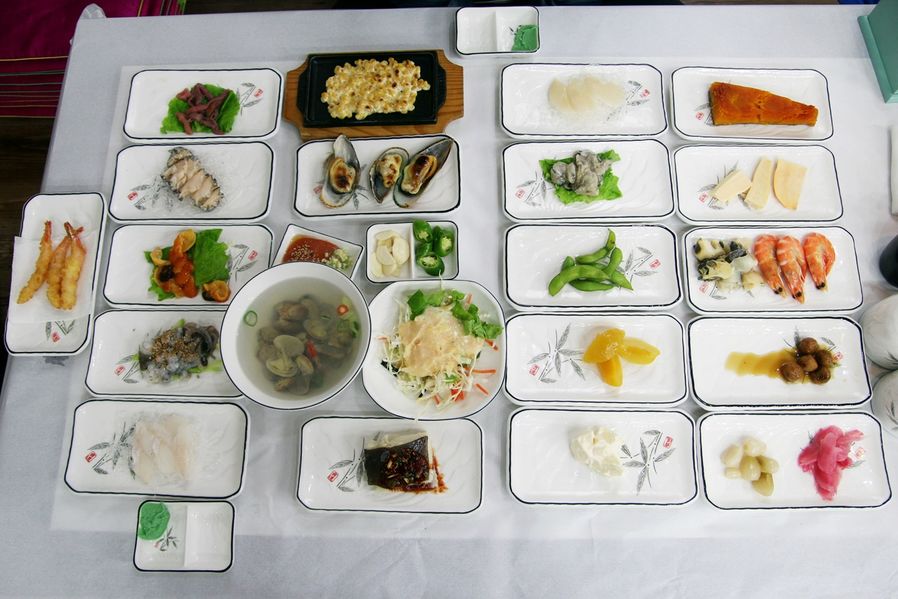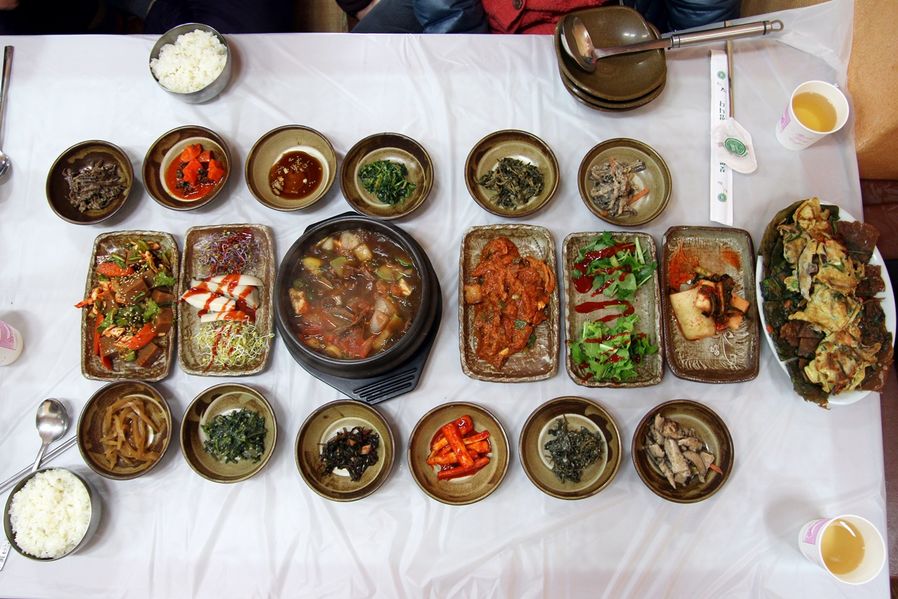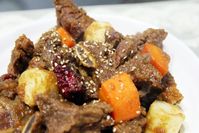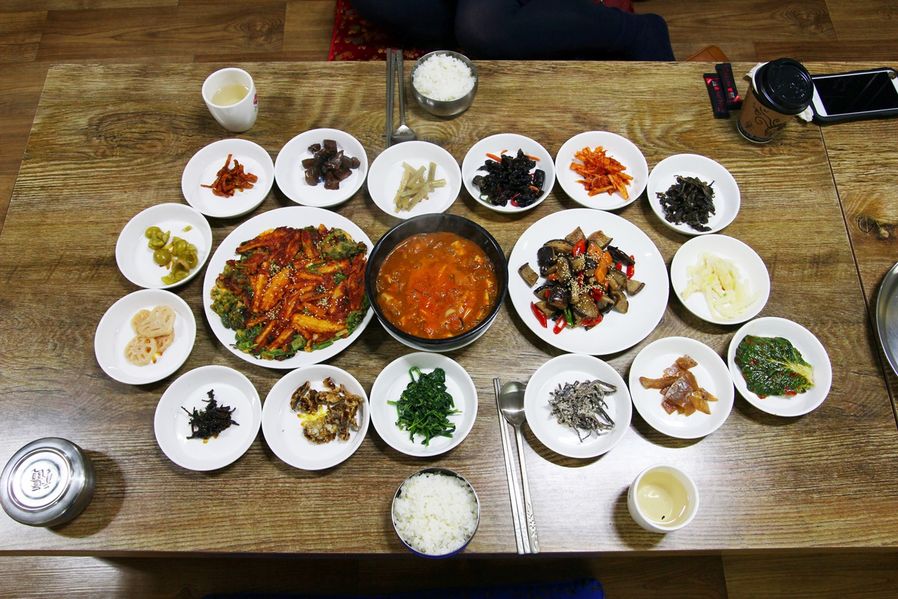1. Ingredients for Hanjeongsik
- Primary ingredients: Steamed rice mixed with grains (barley and brown rice)
- Secondary ingredients: Jjigae (Kimchi-jjigae or Deonjang-jjigae), meat (port, beef), seafood (fish, oyster, etc.) and various vegetable dishes
2. Taste evaluation
-Spicy: ★★☆☆☆
-Salty: ★★☆☆☆
-Sweet: ★☆☆☆☆
-Sour: ★☆☆☆☆
-Other flavors: Various flavors depending on dishes
3. Introduction to Hanjeongsik(Korean table d’hote)
In a broad sense, Hanjeongsik is traditional Korean table d’hote and in a narrower sense, it refers to fancy and formal Korean table just like a former dinner table in the West.
These days, people mean the latter, fancy Korean table d’hote, when they say Hanjeongsik. As you can notice, Hanjeongsik is not one cuisine but traditional Korean table.
Hanjeongsik was originated from the era when the people started to produce rice based on grain production from the New Stone Age.
In old times, people ate seasonal ingredients along with rice and barley but they started to prepare rice separated from dishes.
Traditional Korean table d’hote could be called 3-Cheop, 5-Cheop, 7-Cheop, 9-Cheop and 12-Cheop depending on the number of extra dishes.
If three more side dishes are added to basic table of rice, soup and Kimchi, it is called 3-Cheop and if 5 more side dishes are added it’s called 5-Cheop.
3-Cheop and 5-Cheop tables was for ordinary people and tables with 7 or 9 side dishes were for rich Yangban while the table with 12 side dishes was for the King(royal table).
However, there is no difference in food by status or wealth, and 3-Cheop dishes are enough for daily meal while 7-Cheop dishes are served on special occasions like birthdays or anniversaries.
Hanjeongsik mostly is divided into two groups, rice and dishes.
For rice, you could choose white rice, barley or brown rice, all of which are steamed without any seasoning, and dishes are various foods that are served with rice.
Dishes consist of soup (soup or Jjigae) and other ingredients cooked in different ways such as meat, seafood and vegetables.
For Jjigae, there are Deonjang Jjigae and Kimchi Jjigae, and other dishes would include stir-fried vegetables, fried meat and braised fish.
Most Korean people eat rice with soup (soup or Jjigae) and three-to-four dishes. For example, rice, Kimchi Jjigae, fried eggs, stir-fried fish cake and Kimchi would be served on the table for meal.
On special days like birthdays or anniversaries, white rice, Jeongol(soup), Galbi(ribs), Buchimgae(vegetable pancakes), Japchae(stir-fried glass noodles and vegetables), Naengchae(chilled vegetables), Kimchi and so on.
The more special day it is, the more expensive ingredients will be used and the more dishes there will be. But basically, Korean meal has rice, which is a kind of grain, and a few dishes.
So far, you might have noticed that Hanjeongsik is traditional table for Koreans in a broad sense.
In fact, Hanjeongsik is well known as fancy Korean traditional table.
Fancy Hanjeongsik restaurants will have course menus like formal dinner tables in Western countries.
At first, appetizers are served to increase appetite that mostly consist of warm porridge and sweet salads.
When you’re done, main dishes are served. It consists of a bowl of rice and dozens of dishes. Most Hanjeongsik would have 10-20 dishes including Jeongol(stew), Galbi(ribs), Japchae(stir-fried glass noodles and vegetables), braised fish Buchimgae(vegetable pancake) and boiled vegetables.
And after you have a meal, beverages such as Sikhye (sweet rice drink) or Sujeonggwa (persimmon punch) and desserts like Tteok (rice cake) and Korean traditional sweets will be served.
These restaurants do not use too much salt or too strong sauce in order for you to taste the original flavors of ingredients.
If you’re tired of spicy and salty Korean food during your trip, you should try Hanjeongsik because so many dishes with plain flavors will be served that you can choose according to your preferences.
Plus, Hanjeongsik has all traditional Korean foods served on a table so you could taste different kinds of Korean food in one meal.
Search on Wikipedia
4. Kinds of Hanjeongsik
Since Hanjeongsik is traditional Korean meal table, there are many kinds depending on regional special food, cook in each restaurant or each family tradition.
The most basic table would have rice, Jjigae(soup), Kimchi and two or three dishes.
A few more dishes are added in case of parties or table for guests.
Seoul style Hanjeongsik has rice, soup, Jjigae, Japchae(glass noodles with sautéed vegetables) and Buchimgae.
And in regions near the ocean, the dishes are mostly made from seafood such as fish and oysters.
Among many Hanjeongsik, Jeollanamdo style is the most famous. It serves 30-40 dishes with extra seafood dishes based on Seoul style Hanjeongsik.

Canon EOS 550D | f/4.0 | iso 500 | 2012:04:04 19:55:44 | Flash did not fire, compulsory flash mode | 17mm
5. How to enjoy Hanjeongsik even more
Traditionally, you’re not allowed to talk during the meal in Korea.
It’s because you might spit out food if you speak with your mouth full. So the meal time in Korea is rather short compared to other countries because Koreans focus on eating without talking.
Even when they eat Hanjeongsik which literally has dozens of dishes served, they finish eating in 30 minutes.
So one day, I took my foreign friends to Hanjeongsik restaurant, they were shocked by how people sitting at the next tables finished the meal so fast. And they felt pressured to eat quickly like them.
But there’s no need for that.
Enjoy each dish and have a little talk with your friends.
It’s impolite to be chatty at the dinner table with food coming out of your mouth in Korea but it’s not like they just sit there without talking at all.
Koreans also enjoy conversation while having meal slowly today.
And Hanjeongsik is quite expensive so you might as well try decent one where the food is delicious, agreed?
That’s why you need to carefully choose Hanjeongsik restaurant by googling or asking your friends for help.
Nice Hanjeongsik restaurants mostly have very good cooks with decades of experience in the field and the restaurants would be built as Korean style house called Hanok.
Not everyone in Korea could afford this nice meal that often, so it would be special experience for you to try well-prepared Hanjeongsik at least for once.












